|
Report
from
Europe
Sharp rise in EU imports of hardwood plywood
In the first six months of 2014, EU28 imports of hardwood
plywood were 1.21 million cubic metre, 12% more than
the same period the previous year. This follows stable
imports between 2012 and 2013 (Chart 1).

Most of the gains this year have been in imports from
China and temperate forest regions. After declining 3.5%
between 2012 and 2013, EU imports of hardwood
plywood from China increased 11% to 519,000 cubic
metre in the first six months of 2014. Imports from Russia
climbed 15% to 412,000 cubic metre in the first six
months of 2014, building on the 8% rise in imports
recorded the previous year.
Imports in the first six months of 2014 also rose strongly
from Belarus and Ukraine. However imports from
Uruguay have been declining (Chart 2).

¡¡
Firm European demand for Chinese hardwood
plywood
There has been firm demand for Chinese hardwood
plywood in Europe this year. Officially reported imports
of Chinese hardwood plywood have risen into all the
leading EU markets during 2014 with the exception of
Germany (Chart 3).
Demand has been particularly strong in the large UK
market, led primarily by strong recovery in construction
and also benefitting from improving sales to the shopfitting,
furniture and packaging sectors. Nevertheless,
there remains considerable resistance to increased prices in
the highly competitive UK market.
This trend has favoured Chinese products which tend to be
more competitively priced than South East Asian products.
China‟s share of the UK market has been rising sharply
this year, mainly at the expense of Malaysia.
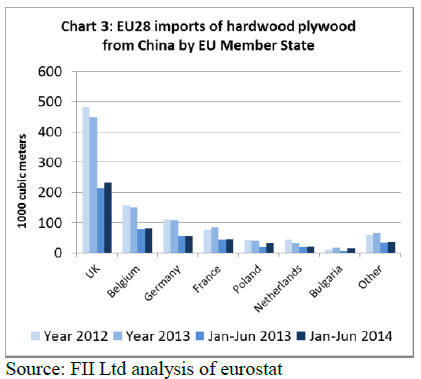
While UK buyers often seem more inclined to
compromise on quality rather than on price, some
importers are raising concerns about the quality of Chinese
plywood arriving in the country.
There are reports, for example, of thin and low quality
veneers for plywood products claimed to be compliant
with the BS1088 standard for marine plywood.
The apparent decline in imports of Chinese hardwood
plywood into Germany may be partly due to emerging
signs of weakness in German construction and other
continental European countries in the second quarter of
2014.
However it also reflects the recent practice by German
customs to record some plywood imports from China as
LVL thereby pushing them into a higher tax bracket.
This issue has been raised with the German customs
authorities by the German timber trade association GD
Holz. As a result, some Chinese products currently
included under LVL in German trade statistics may be
reclassified and plywood import statistics for 2013 and
2014 amended.
After a period of tight supply for mixed light hardwood
plywood from China in the first quarter of 2014 due to
restricted availability of eucalyptus and poplar veneer, the
supply situation eased in the second quarter of the year.
Delivery times to Europe currently stand at around 4 to 5
weeks.
FOB prices for mixed light hardwood plywood from
China were holding steady in the three months before the
Chinese New Year, but prices increased in March and
April this year to accommodate rising prices for
eucalyptus and poplar veneer. Prices have since stabilised
at the higher level.
CIF prices for delivery of Chinese plywood to Europe
have been less certain due to continuing fluctuations in
freight rates. After recovering to US$1300 per TEU in
early July, the Shanghai-North Europe freight index
dipped again to US$1,230 at the end of July and then
jumped to US$1,455 in the first week of August.
It remains to be seen whether shipping companies will be
able to maintain these higher rates during the autumn
months.
Mixed fortunes for tropical hardwood plywood in
Europe
The fortunes of tropical hardwood plywood in the EU
market have been mixed in 2014 (Chart 4).
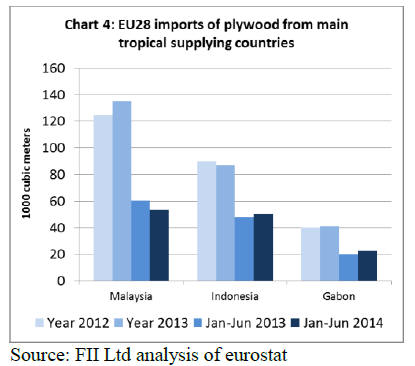
Imports from Malaysia declined 12% to 53,300 cubic
metres in the first 6 months of 2014, a turnaround
following a 9% increase in imports from Malaysia the
previous year.
This is partly explained by rising prices for Malaysian
plywood in 2014 due to various factors including: the
increase in GSP duties from 3.5% to 7% on 1 January
2014; higher production and freight costs during 2014; and
robust sales in other parts of the world, including the US
and Middle East.
Prices for Malaysian raw plywood on offer to European
buyers currently stand at around Indo 96+32%.
Higher prices for Malaysian plywood have particularly
undermined demand in the relatively large but price
conscious UK market.
However, imports of Malaysian plywood into the main
continental European markets have increased this year
(Chart 5).
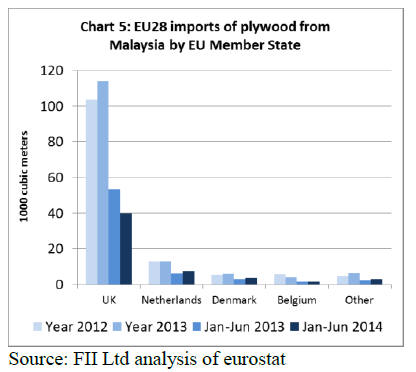
Imports of hardwood plywood from Indonesia were up 5%
in the first six months of 2014 following a decline in
imports the previous year. Imports into Belgium declined
by 25% but this was offset by rising imports into the UK,
Germany, Netherlands, and Italy (Chart 6).
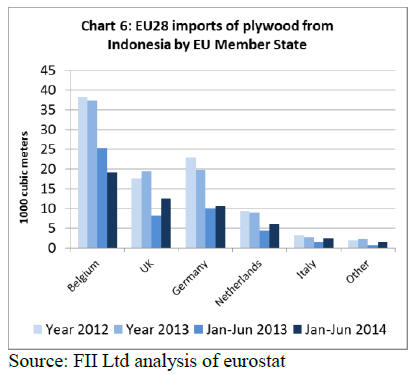
Like Malaysian products, Indonesian plywood prices have
been rising this year and currently stand at around Indo '96
+40% for raw plywood. Much of the gain in prices is due
to rising log costs in Indonesia and higher freight rates,
both for break bulk and container shipment.
However, Indonesian plywood continues to benefit in the
EU market from relatively high prices for competing
Russian and European birch plywood. Break-bulk
shipments of Indonesian plywood to Europe are now
occurring around once every two to three months and are
heavily subscribed.
EU plywood imports from Gabon are low but rising
EU imports of hardwood plywood from Gabon were 10%
higher in the first six months of 2014 compared to the
same period the previous year. Imports into France
declined, but this was offset by rising imports into
Netherlands, Italy and Belgium (Chart 7).
This is despite the change in Gabon‟s GSP status which
led to imposition of a 7% tariff on EU imports of
hardwood plywood from Gabon at the start of 2014.
Imports this year have also been disrupted by occasional
strikes by customs officials at Libreville port in Gabon.
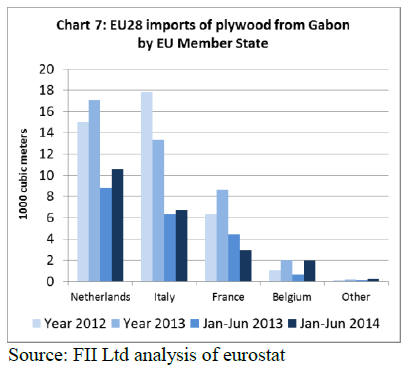
Both EU manufacturers and importers report better
demand for okoume plywood in 2014 than in the previous
year. This is driven by improved construction activity in
the opening months of 2014 in Netherlands and Belgium
and, more recently, by rising boat-building in Italy.
However European consumption of okoume plywood is
still very low by historical standards. Much of the existing
demand is for FSC certified products. Apart from
increases due to the imposition of higher export tariffs,
prices for okoume plywood imported from Gabon have
remained stable during the first half of 2014.
Following lobbying by associations representing
European plywood manufacturers, the EU has reduced the
tariff on imports of okoume veneer under product code
4408393010 from 7% to 0%. The tariff reduction was
announced in European Council Regulation No 722/2014
of 24 June 2014 and backdated to 1 January 2014.
This reverses the increase imposed at the start of the year
due to the change in Gabon‟s GSP status. The reduction
does not apply to plywood imported from Gabon which
continues to be subject to the 7% tariff. Gabon industry
representatives have expressed concern that this measure
favours EU-based over Gabon-based manufacturers.
UK demand boost EU imports of softwood plywood
In the first six months of 2014, EU28 imports of softwood
plywood were 898,000 cubic metres, 17% more than the
same period the previous year (Chart 8).
Imports from Brazil increased 19% to 657,000 m3 in the
first half of 2014. There was also a 26% rise in imports
from China to 97,400 cubic metres, and a 5% increase
from Chile to 72,300 cubic metres.

Much of the gain in imports was due to improving market
conditions in the UK. However imports also increased into
Belgium, Italy, Denmark and the Netherlands in the first
half of 2014. Imports into Germany and France have been
weaker this year (Chart 9).
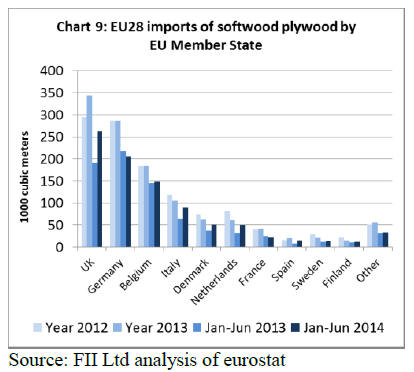
A large proportion of softwood plywood imported into the
EU each year arrives in the first quarter as importers rush
to benefit from the annual duty free quota of 650,000
cubic metres. This year there was a particularly strong
surge in imports in January, but imports slowed
dramatically in February and only recovered a little
ground in the March to June period.
While consumption of softwood plywood has been good
in the UK this year, disappointing construction activity in
the spring months in other European markets has
weakened demand elsewhere. European importers have
been resistant to the higher prices asked by Brazilian
exporters following rapid appreciation of the real
exchange against the dollar in the first four months of this
year. Brazilian exporters have also faced higher log,
energy and wage costs this year.
In previous years, Brazilian suppliers have lowered prices
for softwood plywood in Europe by an amount equivalent
to the 7% duty rate once the duty-free quota is used up.
However this year they have had little incentive to reduce
prices to European buyers at a time of robust demand in
North America.
Variable prospects for EU plywood market
While market conditions for plywood in Europe have
improved in 2014, recent construction data and other
economic indices suggest future prospects remain variable
and uncertain. The EU Construction Production Index,
having made gains between March 2013 and January
2014, lost ground in the months to June 2014. The
slowdown was particularly evident in Germany but also
affected Poland, Belgium and Spain (Chart 10).
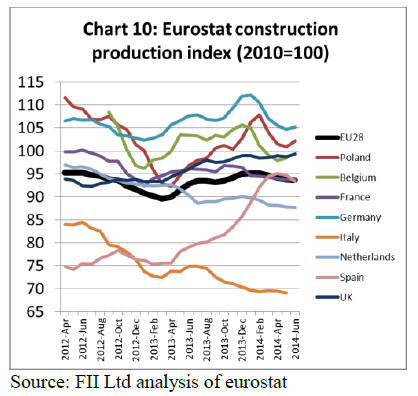
There are also emerging signs that the recovery in the
broader euro-zone economy may be stalling. The eurozone
recorded zero GDP growth in the second quarter of
2014. It had been expected to grow, if barely, but was
dragged down by worse than expected GDP data from
Germany and France. Germany‟s economy contracted by
0.2% as both its export industry and domestic construction
sector struggled. France registered a second straight
quarter of zero growth.
However prospects remain good in the UK. In August, the
UK Construction Products Association (CPA) revised its
forecast for construction output growth this year to 4.7%,
up from 4.5% forecast in April. The CPA growth forecast
for next year is 4.8%. Growth is expected to be fuelled by
rapid expansion in private housing starts and commercial
offices.
CPA expects private housing starts to grow 18.0% in 2014
and 10.0% in 2015, while commercial offices output are
forecast to grow 10.0% in 2014 and 8.0% in 2015. Overall
levels of UK construction activity will likely match their
2007 peak in 2017.
* The market information above has been generously provided
by the Chinese Forest Products Index Mechanism (FPI)
|